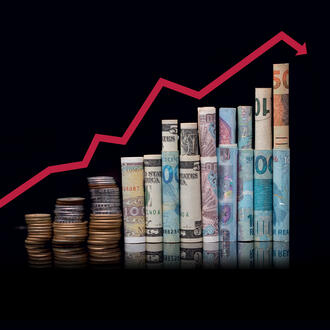Credit: Jake Belcher
To borrow a line from poetry, James Simons knows several lives worth living.
As a world-renowned mathematician, Simons co-developed the influential Chern-Simons theory and worked as a Cold War codebreaker. As a pioneering quantitative investor, Simons founded Renaissance Technologies, known for its secretive and wildly profitable Medallion Fund. And in his current role as a philanthropist, Simons and his wife Marilyn established Math for America and have given billions to science-backed projects through The Simons Foundation.
Yet when a student asked him recently about life lessons, Simons’ recommendation was decidedly un-quant-like.
“Be guided by beauty,” he advised. “Beauty is an aesthetic. There is beauty in things that work really well — the way a company is run, or the way a theorem comes out.”
This spring, Simons, who holds degrees from MIT and University of California, Berkeley, received the S. Donald Sussman Fellowship, awarded to individuals or groups who exhibit innovation and excellence in quantitative investment strategies and models.
In accepting the fellowship, Simons, 80, gave a series of talks at MIT on math, money, and making a difference.
His advice:
“Don’t give up easily. Stick to something. Not to the point where it’s clearly insane, but be persistent.”
While teaching at MIT, Simons convinced two Colombian friends, fellow students from his undergrad days, to start a business.
“They were very smart guys and had a very good sense of business. I said, ‘I’m coming down and I won’t leave until you’ve found something.’”
They settled on manufacturing vinyl floor tiles. Simons and his father both invested in the venture — the difference being the younger Simons didn’t have any money.
“I had to borrow from everyone,” he recalled, “but I was able to invest a small amount.”
Returns were disappointing, however, until the company pivoted to take advantage of a burgeoning demand for PVC pipe fittings, after which business boomed.
“That company did poorly, and then it did wonderfully,” Simons said. “Businesses are often that way. If you start off doing one thing and it doesn’t go well, you change and do something else. It’s not often that the original plan works perfectly.”
“Getting fired once can be a good experience. You just don’t want to make a habit of it.”
Simons’ desire to repay the money he’d borrowed led him to the Institute for Defense Analyses, which was hiring mathematicians to crack Russian codes, and paying them well.
Simons liked the work: “The deal was you could spend half your time on your own mathematics, and half your time on their stuff. And my math started going very well,” he recalled.
But he didn’t see eye to eye with his boss, Gen. Maxwell Taylor. When Taylor wrote an article in the New York Times Magazine supporting the Vietnam War, Simons published a counter-editorial, also in the Times, saying that not everyone who worked for Taylor subscribed to his views.
That caught the attention of a stringer from Newsweek, who asked for an interview, during which Simons laid out his plan: While the war was still on, he’d work 100 percent of his time at IDA on his own mathematics. Once the war ended, “then I’d work an equal amount of time only on their stuff, and it’d all balance out,” he recounted, laughing.
When he told his superiors about the interview, they weren’t amused. He was fired.
“But it was fine. I knew I would get a good job somewhere because of the [mathematics] work I had done,” Simons said.
That job turned out to be as chairman of the math department at Stony Brook University, where he stayed until he shifted to finance in 1976.
“Work with the smartest people you can. Hopefully smarter than you even. It amplifies your effect.”
Simons started out trading currencies and had some success.
“The fundamental trading did quite well. But I kept thinking, could we systematize it, could we put math to it; algorithms?”
Simons brought in mathematician Leonard Baum, and later, James Ax, the first of many hires outside the traditional finance field. Renaissance Technologies, founded in 1982, is still infamous for passing over MBAs and finance PhDs in favor of physicists, mathematicians, even astronomers. But it's not always the easiest cohort to manage.
“It’s unbelievably difficult to manage intelligent people, and it’s worse when there’s a lot of money involved,” said Andre Stern, a partner at Oxford Asset Management, who introduced Simons during one of his talks at MIT Sloan. “I don’t know many people who do it as well as [Simons] does.”
“Hire the smartest people you possibly can,” Simons advised. “Work collaboratively, and let everyone know what everyone else is researching, so people aren’t wasting their time.”
Simons, who retired from Renaissance in 2009 but remains a non-executive chairman and adviser, is most proud of the team he built.
“My biggest contribution was to hire great young people into the business,” he said. “We have great leaders, and they carried on. They haven’t missed a beat.”
“You never know where good science is going to take you.”
From Math for America, which offers fellowships to math and science teachers in New York City, to the Simons Foundation’s far-reaching research in the fields of neuroscience, theoretical computer science, astrophysics, computational biology, and quantum physics, science is always at the core of Simons’ philanthropy.
Simons is happy to fund research in areas that might not attract much attention.
“I’m curious about a lot of things," Simons said. "I really would like to know the origins of life. But I don’t think the NIH [National Institutes of Health] cares where we came from, so it’s not easy for scientists to get grants on that topic.”
Which is why the $40.1 million Simons Observatory will consist of a series of telescopes to study the cosmic microwave background, the most ancient light in the universe, for signs of how the universe began and how it expanded.
Asked how he and Marilyn sorted through multiple requests for support from every quarter, Simons said, “the world is full of good causes. We want to be intelligent about what we give, and narrowing it down to science helps us decide.”
Read next: SEC pick Gary Gensler on fintech, regulation, and blockchain



